Unit 5 Humans and Nature Writing Workshop(教学课件)北师大版(2019)必修第二册(共30页PPT)
文档属性
| 名称 | Unit 5 Humans and Nature Writing Workshop(教学课件)北师大版(2019)必修第二册(共30页PPT) | 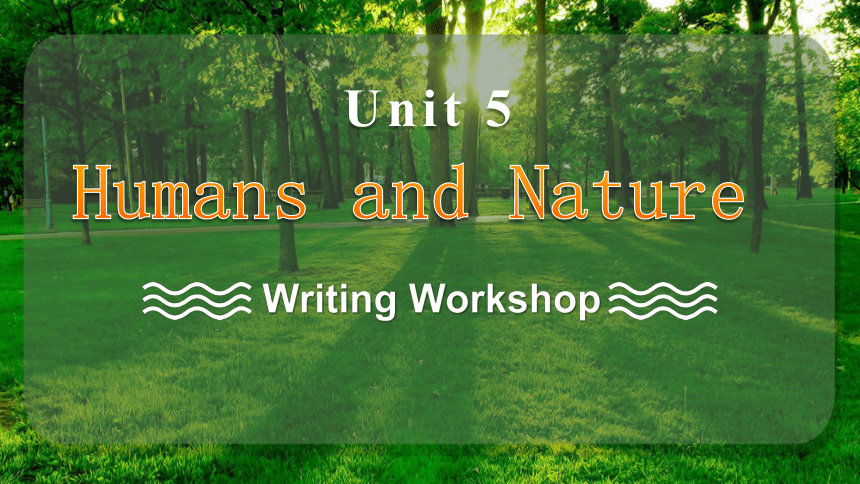 | |
| 格式 | pptx | ||
| 文件大小 | 25.0MB | ||
| 资源类型 | 教案 | ||
| 版本资源 | 北师大版(2019) | ||
| 科目 | 英语 | ||
| 更新时间 | 2025-08-01 10:59:16 | ||
图片预览


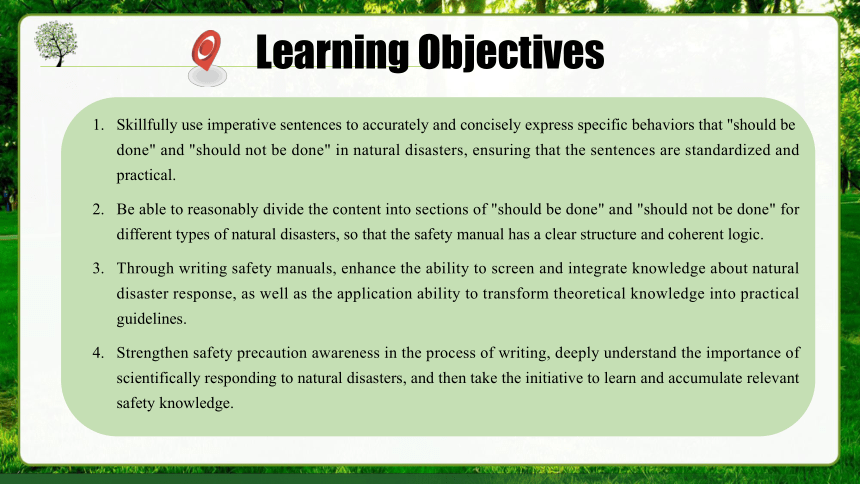


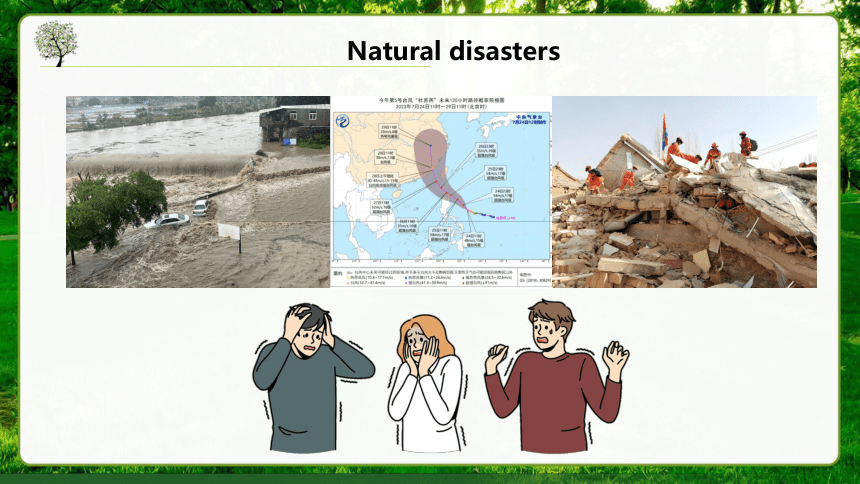
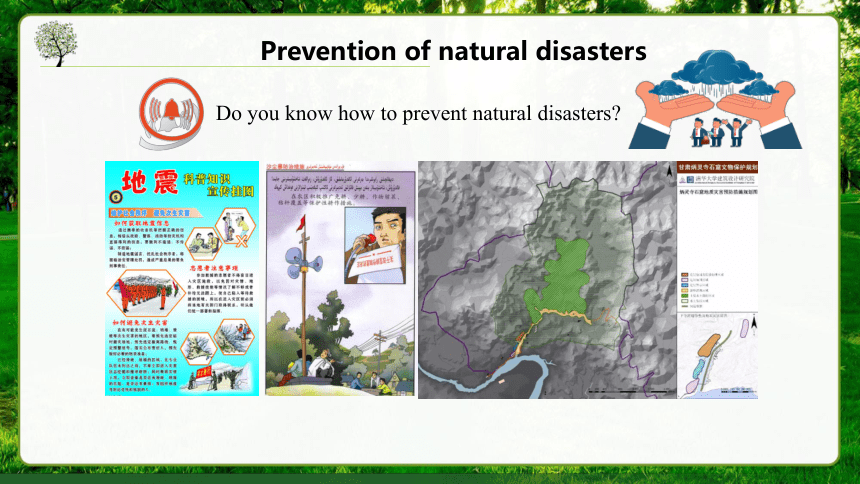
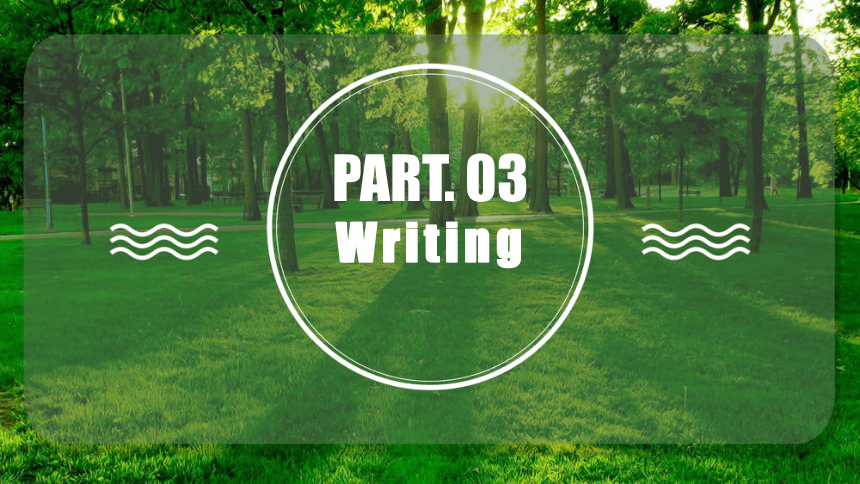
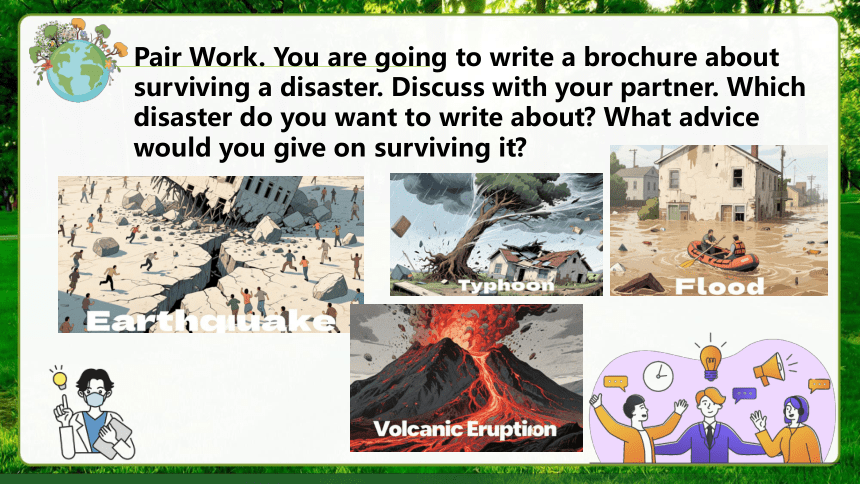
文档简介
(共29张PPT)
Humans and Nature
Unit 5
Writing Workshop
PART. 01
Learning Objectives
Learning Objectives
Skillfully use imperative sentences to accurately and concisely express specific behaviors that "should be done" and "should not be done" in natural disasters, ensuring that the sentences are standardized and practical.
Be able to reasonably divide the content into sections of "should be done" and "should not be done" for different types of natural disasters, so that the safety manual has a clear structure and coherent logic.
Through writing safety manuals, enhance the ability to screen and integrate knowledge about natural disaster response, as well as the application ability to transform theoretical knowledge into practical guidelines.
Strengthen safety precaution awareness in the process of writing, deeply understand the importance of scientifically responding to natural disasters, and then take the initiative to learn and accumulate relevant safety knowledge.
Teaching Focuses and Anticipated Difficulties
The writing characteristics and main contents of the safety manual.
The use of appropriate language to express safety knowledge of specific natural disasters.
PART. 02
Lead-in
Natural disasters
Prevention of natural disasters
Do you know how to prevent natural disasters
PART. 03
Writing
Pair Work. You are going to write a brochure about surviving a disaster. Discuss with your partner. Which disaster do you want to write about What advice would you give on surviving it
Read the brochure about surviving an earthquake on page 41. Underline what you should do when you're indoors, outdoors and in a car.
Read the brochure about surviving an earthquake on page 41. Underline what you should do when you're indoors, outdoors and in a car.
Read the brochure again. Complete the table.
How to Survive an Earthquake
Situation 1:
Situation 2:
Situation 3:
If you're indoors:
Don't run, but protect yourself.
Drop, cover and hold on.
Move away from anything that can fall.
Find a shelter where you can stay.
Wait before moving to another place.
If you're outdoors:
If you're in a car:
Stop,
Stay seated.
Drive carefully when the quake stops.
Look at the Sentence Builder. Write a few sentences that you may want to include in your brochure about Dos and Don'ts for surviving a particular disaster.
Sentence Builder
Imperatives for Dos and Don'ts
Dos
Drop down onto your hands and knees.
Cover your head and neck with your hands, arms or hard objects.
Don'ts
Don't try to run out of the building during an earthquake.
Dos:
Don’ts:
Move to a safe place such as under a sturdy table or against an interior wall if you are indoors.
Don't stand near windows, shelves, or other objects that may fall and hurt you.
Outlining. Use the structure in Activity 3 to prepare an outline for your brochure.
Writing Help
Writing a Brochure
It's important to:
be clear and direct;
use simple and clear language. Make the information easy to remember;
give advice with reasons for actions in different situations;
use the present tense and imperatives;
include pictures and key words to show the important actions.
How to Survive a Typhoon
1. Before the Typhoon
Dos
Don’ts
2. During the Typhoon
Dos
Don’ts
3. After the Typhoon
Dos
Don’ts
Drafting. Use your outline and the Writing Help to write your first draft.
Writing Help
Writing a Brochure
It's important to:
be clear and direct;
use simple and clear language. Make the information easy to remember;
give advice with reasons for actions in different situations;
use the present tense and imperatives;
include pictures and key words to show the important actions.
How to Survive a Typhoon
1. Before the Typhoon
Check weather forecasts regularly and prepare an emergency kit.
Don’t ignore evacuation warnings; delay leaving dangerous areas.
2. During the Typhoon
Stay away from windows, glass doors, and exterior walls.
Don’t attempt to walk or drive through floodwaters
3. After the Typhoon
Wait for official confirmation that it’s safe before going outside.
Don’t touch downed power lines—report them to authorities.
Editing. Edit your brochure in pairs. Then share what you have written in class.
Writing Help
Writing a Brochure
It's important to:
be clear and direct;
use simple and clear language. Make the information easy to remember;
give advice with reasons for actions in different situations;
use the present tense and imperatives;
include pictures and key words to show the important actions.
How to Survive a Typhoon
1. Before the Typhoon (Precaution)
Check weather forecasts regularly and prepare an emergency kit.
Don’t ignore evacuation warnings; delay leaving dangerous areas.
2. During the Typhoon (Safety Actions)
Stay away from windows, glass doors, and exterior walls.
Don’t attempt to walk or drive through floodwaters
3. After the Typhoon (Post-Disaster Steps)
Wait for official confirmation that it’s safe before going outside.
Don’t touch downed power lines—report them to authorities.
How to Survive an Earthquake
indoor
outdoor
in a car
sheltered adj.遮蔽的;受庇护的
shelterer n.避难者
例题:
We took ___________ under a big tree when it started to rain.
Vocabulary
1. shelter
shelter
take shelter 躲避;避难
shelter from 躲避
Vocabulary
2. observe
observation n.观察;观测
observant adj.善于观察的;机警的
observer n.观察者;观测者
例题:
The scientist ___________ the stars carefully every night.
observed
observe sb. do/doing sth. 观察某人做某事
observe a rule 遵守规则
Vocabulary
3. metal
metallic adj.金属的;含金属的
metallurgy n.冶金学
例题:
The statue is made of a kind of shiny ___________.
metal
heavy metal 重金属
metal industry 金属工业
Vocabulary
4. aftershock
shock v.使震惊;使受电击 n.震惊;休克;电击
shocking adj.令人震惊的;骇人听闻的
shocked adj.感到震惊的;惊愕的
例题:
Many people were still afraid to go back home after the strong ___________.
aftershock
PART. 04
Exercise
Exercise: Word spelling.
1. After the heavy rainstorm caused severe flooding in the area, many homeless people had to seek temporary accommodation in the local s_______ set up by the government.
2. Seismologists warned that even small a_________ following a major earthquake could still pose a threat to the already damaged buildings.
3. In order to ensure the accuracy of the scientific experiment, the researchers needed to carefully o________ every change in the experimental data and record them in detail.
4. The ancient bridge was built with a combination of stone and m_________, which made it strong enough to withstand the test of time and various natural disasters.
helter
ftershock
bserve
etal
Exercise: Fill in the blanks with the appropriate forms of the given words.
1. By the end of last week, over 2,000 safety ______________ (brochure) had been distributed to the residents in the disaster - prone area.
2. Since the major earthquake, several small ______________ (aftershock) have been recorded by the local seismological station.
3. The researchers __________________ (observe) the behavior of animals in the wild for months to find clues about natural disaster prediction.
4. All the emergency doors in the building ______________ (make) of strong metal to resist impact during earthquakes.
brochures
aftershocks
have been observing
are made
PART. 05
Summary
添加标题
ADD THE TITLE HERE
Writing Workshop
Vocabulary
Safety manuals
Imperative sentences
Writing
shelter, observe, metal, aftershock
PART. 06
Homework
Homework
Write down the safety knowledge you know using imperative sentences.
See you next class!
Humans and Nature
Unit 5
Writing Workshop
PART. 01
Learning Objectives
Learning Objectives
Skillfully use imperative sentences to accurately and concisely express specific behaviors that "should be done" and "should not be done" in natural disasters, ensuring that the sentences are standardized and practical.
Be able to reasonably divide the content into sections of "should be done" and "should not be done" for different types of natural disasters, so that the safety manual has a clear structure and coherent logic.
Through writing safety manuals, enhance the ability to screen and integrate knowledge about natural disaster response, as well as the application ability to transform theoretical knowledge into practical guidelines.
Strengthen safety precaution awareness in the process of writing, deeply understand the importance of scientifically responding to natural disasters, and then take the initiative to learn and accumulate relevant safety knowledge.
Teaching Focuses and Anticipated Difficulties
The writing characteristics and main contents of the safety manual.
The use of appropriate language to express safety knowledge of specific natural disasters.
PART. 02
Lead-in
Natural disasters
Prevention of natural disasters
Do you know how to prevent natural disasters
PART. 03
Writing
Pair Work. You are going to write a brochure about surviving a disaster. Discuss with your partner. Which disaster do you want to write about What advice would you give on surviving it
Read the brochure about surviving an earthquake on page 41. Underline what you should do when you're indoors, outdoors and in a car.
Read the brochure about surviving an earthquake on page 41. Underline what you should do when you're indoors, outdoors and in a car.
Read the brochure again. Complete the table.
How to Survive an Earthquake
Situation 1:
Situation 2:
Situation 3:
If you're indoors:
Don't run, but protect yourself.
Drop, cover and hold on.
Move away from anything that can fall.
Find a shelter where you can stay.
Wait before moving to another place.
If you're outdoors:
If you're in a car:
Stop,
Stay seated.
Drive carefully when the quake stops.
Look at the Sentence Builder. Write a few sentences that you may want to include in your brochure about Dos and Don'ts for surviving a particular disaster.
Sentence Builder
Imperatives for Dos and Don'ts
Dos
Drop down onto your hands and knees.
Cover your head and neck with your hands, arms or hard objects.
Don'ts
Don't try to run out of the building during an earthquake.
Dos:
Don’ts:
Move to a safe place such as under a sturdy table or against an interior wall if you are indoors.
Don't stand near windows, shelves, or other objects that may fall and hurt you.
Outlining. Use the structure in Activity 3 to prepare an outline for your brochure.
Writing Help
Writing a Brochure
It's important to:
be clear and direct;
use simple and clear language. Make the information easy to remember;
give advice with reasons for actions in different situations;
use the present tense and imperatives;
include pictures and key words to show the important actions.
How to Survive a Typhoon
1. Before the Typhoon
Dos
Don’ts
2. During the Typhoon
Dos
Don’ts
3. After the Typhoon
Dos
Don’ts
Drafting. Use your outline and the Writing Help to write your first draft.
Writing Help
Writing a Brochure
It's important to:
be clear and direct;
use simple and clear language. Make the information easy to remember;
give advice with reasons for actions in different situations;
use the present tense and imperatives;
include pictures and key words to show the important actions.
How to Survive a Typhoon
1. Before the Typhoon
Check weather forecasts regularly and prepare an emergency kit.
Don’t ignore evacuation warnings; delay leaving dangerous areas.
2. During the Typhoon
Stay away from windows, glass doors, and exterior walls.
Don’t attempt to walk or drive through floodwaters
3. After the Typhoon
Wait for official confirmation that it’s safe before going outside.
Don’t touch downed power lines—report them to authorities.
Editing. Edit your brochure in pairs. Then share what you have written in class.
Writing Help
Writing a Brochure
It's important to:
be clear and direct;
use simple and clear language. Make the information easy to remember;
give advice with reasons for actions in different situations;
use the present tense and imperatives;
include pictures and key words to show the important actions.
How to Survive a Typhoon
1. Before the Typhoon (Precaution)
Check weather forecasts regularly and prepare an emergency kit.
Don’t ignore evacuation warnings; delay leaving dangerous areas.
2. During the Typhoon (Safety Actions)
Stay away from windows, glass doors, and exterior walls.
Don’t attempt to walk or drive through floodwaters
3. After the Typhoon (Post-Disaster Steps)
Wait for official confirmation that it’s safe before going outside.
Don’t touch downed power lines—report them to authorities.
How to Survive an Earthquake
indoor
outdoor
in a car
sheltered adj.遮蔽的;受庇护的
shelterer n.避难者
例题:
We took ___________ under a big tree when it started to rain.
Vocabulary
1. shelter
shelter
take shelter 躲避;避难
shelter from 躲避
Vocabulary
2. observe
observation n.观察;观测
observant adj.善于观察的;机警的
observer n.观察者;观测者
例题:
The scientist ___________ the stars carefully every night.
observed
observe sb. do/doing sth. 观察某人做某事
observe a rule 遵守规则
Vocabulary
3. metal
metallic adj.金属的;含金属的
metallurgy n.冶金学
例题:
The statue is made of a kind of shiny ___________.
metal
heavy metal 重金属
metal industry 金属工业
Vocabulary
4. aftershock
shock v.使震惊;使受电击 n.震惊;休克;电击
shocking adj.令人震惊的;骇人听闻的
shocked adj.感到震惊的;惊愕的
例题:
Many people were still afraid to go back home after the strong ___________.
aftershock
PART. 04
Exercise
Exercise: Word spelling.
1. After the heavy rainstorm caused severe flooding in the area, many homeless people had to seek temporary accommodation in the local s_______ set up by the government.
2. Seismologists warned that even small a_________ following a major earthquake could still pose a threat to the already damaged buildings.
3. In order to ensure the accuracy of the scientific experiment, the researchers needed to carefully o________ every change in the experimental data and record them in detail.
4. The ancient bridge was built with a combination of stone and m_________, which made it strong enough to withstand the test of time and various natural disasters.
helter
ftershock
bserve
etal
Exercise: Fill in the blanks with the appropriate forms of the given words.
1. By the end of last week, over 2,000 safety ______________ (brochure) had been distributed to the residents in the disaster - prone area.
2. Since the major earthquake, several small ______________ (aftershock) have been recorded by the local seismological station.
3. The researchers __________________ (observe) the behavior of animals in the wild for months to find clues about natural disaster prediction.
4. All the emergency doors in the building ______________ (make) of strong metal to resist impact during earthquakes.
brochures
aftershocks
have been observing
are made
PART. 05
Summary
添加标题
ADD THE TITLE HERE
Writing Workshop
Vocabulary
Safety manuals
Imperative sentences
Writing
shelter, observe, metal, aftershock
PART. 06
Homework
Homework
Write down the safety knowledge you know using imperative sentences.
See you next class!
同课章节目录
- Unit 4 Information technology
- Lesson 1 Avatars
- Lesson 2 Apps
- Lesson 3 Internet and Friendships
- Unit 5 Humans and nature
- Lesson 1 A Sea Story
- Lesson 2 Professional Rescue Team
- Lesson 3 Race to the Pole
- Unit 6 The admirable
- Lesson 1 A Medical Pioneer
- Lesson 2 History Makers
- Lesson 3 The Superhero Behind Superman
